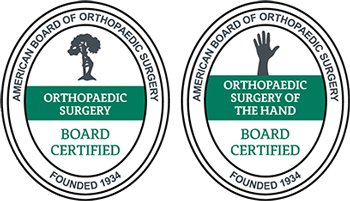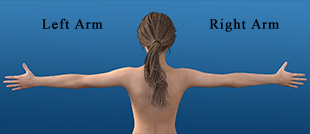Gamekeeper’s Thumb Symptoms & Treatment
Contents
- 1 What is GameKeeper’s Thumb?
- 2 What causes GameKeeper’s Thumb?
- 3 What are the symptoms of GameKeeper’s Thumb?
- 4 How is GameKeeper’s Thumb diagnosed?
- 5 How is GameKeeper’s Thumb treated?
- 6 How can Dr. Knight help you with Gamekeeper’s Thumb?
- 7 Gamekeeper’s Thumb Fact Sheet
- 8 Frequently Asked Questions:
- 9 Videos
- 10 Animated Videos
- 11 Surgical Video
What is GameKeeper’s Thumb?
Gamekeeper’s Thumb, also known as Skier’s Thumb, results from acute or chronic injury of the ulnar collateral ligament (UCL). Ligaments are strong, flexible, fibrous connective tissues that connect bone to bone. The UCL is the main ligament, located on the inner aspect at the base of the thumb, which stabilizes the metacarpophalangeal (MCP) joint. The UCL may be strained or torn (partially or completely) producing a weakened grasping or pinching ability of the thumb.


What causes GameKeeper’s Thumb?
Gamekeeper’s Thumb can be caused by acute injury or chronic overuse. This frequently results from a fall on an outstretched hand that violently pulls the thumb away from the index finger and can stretch or tear the UCL. This is common during skiing accidents when the skier falls without releasing the ski pole. Repetitive use injuries happen from the gradual wearing away of the UCL over time. Gamekeeper’s Thumb generally refers to this chronic type of injury. Rheumatoid arthritis and nicotine use can also weaken the ligaments making them more prone to injury.

What are the symptoms of GameKeeper’s Thumb?
Symptoms are dependent on the cause and severity of injury to the UCL. Various levels of pain, bruising, or edema may present at the site of damage. Weakened grip or reduced thumb range of motion may occur. If the ligament is completely torn there may be a bump on the palmar aspect at the base of the thumb and the thumb may hang at an awkward angle.
How is GameKeeper’s Thumb diagnosed?
Early diagnosis is important in any hand injury to prevent possible long-term effects. In addition to a comprehensive history and review of symptoms, the physician will perform a physical examination of both hands and may order imaging test to confirm diagnosis. The doctor may manipulate the thumb (valgus stress test) in comparison to the opposite thumb to determine if there is any laxity. This may be done under local anesthetic since it can be very painful. X-rays are used to visualize the bones and rule-out possible fractures. MRI (magnetic resonance imaging) and ultrasound may be ordered to observe the severity of soft tissue damage.

How is GameKeeper’s Thumb treated?
Non-surgical
If damage to the UCL is minor non-surgical treatment may be indicated. Ice packs may be used during the first few days after injury to soothe pain and reduce swelling. The doctor will likely immobilize the thumb in a cast or splint which is worn continuously form the first 3 weeks or so. After that time the splint may be removed to perform hand therapy and strength exercises only. Total time in thumb splint is usually about 4 – 6 weeks.

Surgical
Major injury to the UCL will require surgical fixation as soon as possible. Delay in obtaining surgical intervention can increase complications and reduce the likelihood of full return of function. Surgical repair of the UCL can be performed on an outpatient basis using a minimally invasive approach. The ligament is anchored back to the bone using pins or sutures. The thumb is then placed in a cast or splint to protect the repair. Eventually hand therapy is used to restore function and range of motion to the thumb.

How can Dr. Knight help you with Gamekeeper’s Thumb?
Working in sports medicine, Dr. Knight is very familiar with this type of injury and is well versed in its treatment. Upon ascertaining the severity of your case, he will proceed in the manner most appropriate to bring your hand back to full use.
We looking forward to helping you live a more pain free life. Dr. Knight is one of the top hand doctors in Dallas. Visit Dr. John Knight at our Southlake hand and wrist center or Dallas office location.
Gamekeeper’s Thumb Fact Sheet
| Why does gamekeeper's thumb have that name? | Gamekeeper's thumb is also known as Skier's thumb, which is probably a better term for it nowadays, as there are very few gamekeepers around anymore. Originally, the name was given because many gamekeepers came down with the condition due to the way in which they used their thumb and forefinger to snap the necks of rabbits and pest animals during the execution of their duties. |
| How will the doctor test for gamekeeper's thumb? | There are no laboratory tests that aid in the detection of gamekeeper's thumb, but physical examination will allow the doctor to determine the precise nature of the injury, and if the ligament has been partially or fully severed. An X-ray may be utilized to make sure there is no bone involvement or fracture, and MRI can give a better view of the soft tissue, but usually the physical examination will indicate the extent of the damage and the probably course of action. |
| How common is gamekeeper's thumb? | Gamekeeper's thumb accounts for close to 85% of all treated injuries to the base of the thumb, and it is the second most common injury reported as a result of skiing. It can also occur in sports involving bats, or in a fall from a bicycle or motorcycle. That is to say, it is VERY common and any hand specialist will see hundreds of cases a year. |
| What are some symptoms of gamekeeper's thumb? | Pain at the base of the thumb is the most obvious and common symptom, acocmpaneid by swelling and weakness, and loss of the ability to pinch the thumb and forefinger together. In more severe cases, pain from the thumb may be referred to the wrist, but this is not necessarily a diagnostic feature. |
Frequently Asked Questions:
How can you get gamekeeper’s thumb?
Gamekeeper’s thumb is always the result of trauma to the base of the thumb, that causes the thumb itself to jerk out violently from the palm of the hand and the ligament at the base of the thumb metacarpal is torn. This type of injury can be the result of several actions. The name Skier’s thumb comes from the commonness of this injury to skiers, as well as people who play racket sports, because the hand is constantly gripping tightly a handle, which can put strain on the ligament. The name Gamekeepers’s thumb is an older one, and comes from the action of gamekeepers to snap the necks of rabbits and small pest animals, which mimics the action of squeezing a racket or ski handle.
Does gamekeeper’s thumb require surgery?
Surgery is typically only considered for this condition if the ligament at the base of the thumb is fully severed. If the tear is partial, then a cast or a thumb spica splint can be used to immobilize the joint and keep the ligament in place while it heals itself together again. Surgery can take one of two forms, depending on the precise nature of the injury to the ligament. Most commonly, the ligament is torn somewhere along the midline, and is sewn together like two ends of fabric to heal together. More rarely, the ligament may be torn away from the bone directly, and so it has to be sutured directly to the bone, which can necessitate a longer recovery period.
How long does gamekeeper’s thumb take to heal?
Whether treated conservatively or with surgery, the recovery time for a gamekeeper’s thumb is generally from four to six weeks, either in a cast and splint or splinted after surgery. A period of physical therapy will be integral to the recovery process, to ensure that the ligament heals correctly.
Videos
Gamekeeper’s Thumb – All You Need to Know
Animated Videos
Surgical Video
Note: The following videos contains graphic images.
Disclaimer
HandAndWristInstitute.com does not offer medical advice. The information presented here is offered for informational purposes only. Read Disclaimer

























